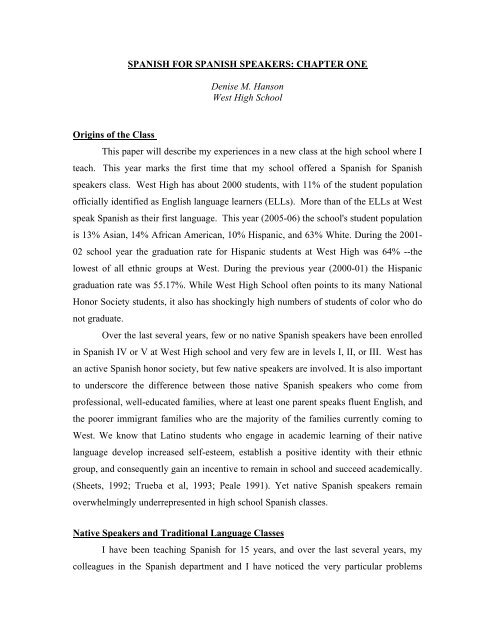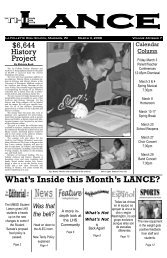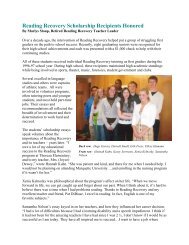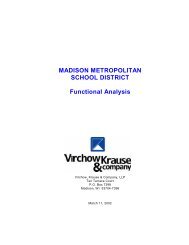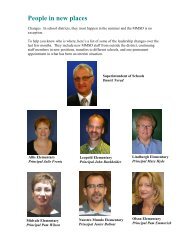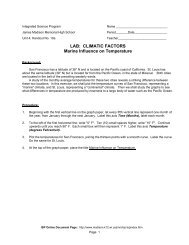Denise Hanson - Malcolm Shabazz City High School, Madison WI ...
Denise Hanson - Malcolm Shabazz City High School, Madison WI ...
Denise Hanson - Malcolm Shabazz City High School, Madison WI ...
- No tags were found...
You also want an ePaper? Increase the reach of your titles
YUMPU automatically turns print PDFs into web optimized ePapers that Google loves.
SPANISH FOR SPANISH SPEAKERS: CHAPTER ONE<strong>Denise</strong> M. <strong>Hanson</strong>West <strong>High</strong> <strong>School</strong>Origins of the ClassThis paper will describe my experiences in a new class at the high school where Iteach. This year marks the first time that my school offered a Spanish for Spanishspeakers class. West <strong>High</strong> has about 2000 students, with 11% of the student populationofficially identified as English language learners (ELLs). More than of the ELLs at Westspeak Spanish as their first language. This year (2005-06) the school's student populationis 13% Asian, 14% African American, 10% Hispanic, and 63% White. During the 2001-02 school year the graduation rate for Hispanic students at West <strong>High</strong> was 64% --thelowest of all ethnic groups at West. During the previous year (2000-01) the Hispanicgraduation rate was 55.17%. While West <strong>High</strong> <strong>School</strong> often points to its many NationalHonor Society students, it also has shockingly high numbers of students of color who donot graduate.Over the last several years, few or no native Spanish speakers have been enrolledin Spanish IV or V at West <strong>High</strong> school and very few are in levels I, II, or III. West hasan active Spanish honor society, but few native speakers are involved. It is also importantto underscore the difference between those native Spanish speakers who come fromprofessional, well-educated families, where at least one parent speaks fluent English, andthe poorer immigrant families who are the majority of the families currently coming toWest. We know that Latino students who engage in academic learning of their nativelanguage develop increased self-esteem, establish a positive identity with their ethnicgroup, and consequently gain an incentive to remain in school and succeed academically.(Sheets, 1992; Trueba et al, 1993; Peale 1991). Yet native Spanish speakers remainoverwhelmingly underrepresented in high school Spanish classes.Native Speakers and Traditional Language ClassesI have been teaching Spanish for 15 years, and over the last several years, mycolleagues in the Spanish department and I have noticed the very particular problems
facing native Spanish speakers in Spanish language classes. Native Spanish speakersoften struggle in traditional Spanish language classes because those classes are notstructured in ways that enhance the native speakers' oral knowledge. To the contrary,their deficits (for instance, in writing) are highlighted and for many of them, theexperience is demoralizing and does little to contribute to their sense of themselves asstudents. The native Spanish speakers' natural mastery of oral Spanish is often scarcelyrecognized and rarely valued in our language programs. Over the years, I have worked toopen my classroom to these students and encourage them to take my classes.Unfortunately, my attempts to move native Spanish speakers into my classroom oftenbackfired when the other students made comments, often sarcastic, to native Spanishspeakers like "What are you doing in this class? You already know Spanish" or worse,"You should know Spanish." As María Kellor, a retired MMSD Spanish teacher noted inher research, "not only is this experience in the Spanish classroom harmful to the Spanishspeaker's desire to learn his own language, it also has a tremendous impact on his selfconcept"(Kellor, unpublished Master's thesis, 29).In short, there is much evidence advocating Spanish classes for native Spanishspeakers. Before my current project began, I specifically catered to the needs of nativeSpanish speakers by individualizing my plans and expectations, giving them moreappropriate literature, and most importantly, asking them to take leadership roles in orderto help other students with oral practice. However, it was clear to me that this was not asufficient response to the problem.The benefits the native-speaking students brought to any Spanish class were clearto me. What was not clear was how to deal with the concerns I had about the nativeSpanish speakers' frequent problems with Spanish language literacy. I knew these wouldcome to the surface, and that I would need to address them. The lack of a strongbackground in Spanish language literacy haunts these students as they struggle withwritten exams, papers, and the like. It is important to note that until recently, foreignlanguage classes nationwide have heavily emphasized writing skills, with grades beingbased mostly on traditional paper and pencil test scores. While there is currently moreemphasis on speaking, the traditional focus continues.
conversation with them. The youth in this class live a different high school experiencethan many of those who are in my Spanish II and III classes whose only responsibility isto do well in school. Many of those kids have privileges beyond the comprehension ofthe kids in the Spanish for Spanish Speakers course. Going home each afternoon, oftento a stay-at-home parent, and a freshly cooked meal in a home owned by the family is notsomething any of my Spanish-speaking students have experienced. In fact, some of mySpanish-speaking students live with cousins or older siblings and have significanteconomic responsibilities at home. All of the students go home to an apartment complexwhere almost all the adults are out working, often two different jobs. Many of them leaveschool to go directly to their own jobs, not arriving home until near bedtime.A graduate student from the UW-<strong>Madison</strong> has integrated herself into our classthis past year as part of her doctoral research on academic achievement and identityamong Latino students. We have worked together on other projects in the past, and ourcurrent research is both parallel and based on ongoing collaboration. Our conversationsand vision of this particular classroom have informed this action research project. Inaddition to her research, based on observations and interviews, she is also a participant inthe class, and has led class discussions on different topics, including the ongoingcontroversy around immigration. Based on discussions with me about the class, she hasinvited several guest speakers (Mexican professionals and activists in the community) tothe class as well, which I feel helps the students perceive themselves as being powerfulwithin the <strong>Madison</strong> community.“Doing <strong>School</strong>” at <strong>Madison</strong> WestFrom the very beginning of the class, I have worked to create a truly democraticclassroom. When the semester started, the students and I discussed the possible differentcomponents of the class (journals, quizzes, homework, etc.) and they were able to vote onthe percentage that each would be worth. This created some problems later on, as thestudents in general have done very poorly in terms of grades, often consistently missingsimple assignments and the like. My goal is to have them take responsibility, and that isoften frustrating. To me, it appears that many students in the class don't know how to"play the game" of school. I have it set up so that if students jump through the hoops that
we have set up as a class, they are able to be successful. Because this class as a whole ismuch more vulnerable than my traditional classes, I have asked to see each student'sprogress reports (for each class) each quarter. I also saw each student's high schooltranscript before school started in September. Some of the students had cumulativeGPAs as low as .8, and the majority were 1.2, 1.8, etc. The highest in the class were thethree Sánchez scholars 1 , each with a GPA of at least 3.0.For example, one of my female students consistently got Bs in my class.However, she was failing every single other class. When I asked her about her grades (Ihave regular personal check-ins with each student), she noted that she had no clear idea inher other classes of what the goals were, and how to be a successful student. I was baffledbecause he English was certainly passable, so that wasn’t the problem. In my class, wework with the class-created expectations. I also let students know that I truly believe thateach and every student is capable of passing the class with a high grade. I did have theluxury this year of having a fairly small class (my traditional Spanish classes havebetween 28-32 students). The small class atmosphere provided me the time to meetalmost weekly individually with each student to help them problem solve, motivate andset personal and academic goals. Not only was I able to meet with them one on one likethis, but I was also able to touch base with some of their other teachers in order to helpthem have more success in all their classes.This class was totally different in pedagogical terms from the traditional Spanishclasses I have taught and continue to teach. Writing has really become the focus to thepoint where I sometimes feel like I'm an English teacher and, in fact, I've spoken toseveral different English teachers at my school about rubrics, writing assignments and thelike in order to prepare for this class. For obvious reasons, much of my focus in mytraditional Spanish classes is on speaking and oral language practice. That is notnecessary in this case, and thus the class experience has been very different for me asteacher.1 The Sánchez scholar program is an endowment left by a former UW professor of Mexican heritage, andadministered by the <strong>Madison</strong> Metropolitan <strong>School</strong> District, which provides incoming high school studentswith financial assistance for each of their high school years. More importantly, it offers the studentsongoing advice and assistance about academic opportunities and the like.
While we have spent a great deal of time reading some of the great Spanishlanguagewriters, we have also, as noted, put a premium on writing. I have structured theclass to be portfolio-based. There were at least three formal writing assignments eachquarter and students were to organize them into a portfolio as half of their final exam.The portfolios also included poems they had written in class, goals, and personal andacademic successes, some graphics, lists of the authors and stories we read in class andreflections. The portfolios that were actually handed in were wonderful—absolutelyheart stopping. Unfortunately, only seven were handed in at the end of the first semester.On a positive note, those who did it were very proud and all earned very high grades, asthe task was simply to put together all that they had done all semester.La Clase Como CasaThis class ended up being a "home base" for these students and at this writing; Iam already realizing how much I will miss that sense of community and comfort in theclassroom. Though many of these students had very difficult times in traditional Spanishclasses, the very fact that they were all together in this classroom created a bond andcomfort level that was crucial for them. Their experiences in the traditional Spanishclasses were often humiliating and demoralizing. At the beginning of the year when wetalked about their experiences in other Spanish classes only one had had a positiveexperience—all the others had failed either Spanish II, Spanish III or Spanish IV. Part ofmy strategy in creating a community of learning that was also safe and recognized theirstrengths and language expertise is that from the very start, I have been very clear aboutthe fact that I realize that I am a white, native English speaker. I am clear about the factthat I know Spanish and that I know it well, but I also consistently acknowledge what areoften their superior skills -- they may not always know what part of speech they areusing, but they "know" their Spanish in a profound way, and in some ways, they knowmore than the teacher knows. I want them to see me as a learner as well, and understandthat we are all lifelong learners.This has led to many fun moments and a sense of playfulness in the classroom, asI give them full permission to call me on any errors I may make. In fact, if they are rightwhen they call me on it, they get an extra credit point. This tends to make the class much
more attentive and clearly gives them a sense of great pride and self-empowerment.They see me as their teacher, but in no sense as someone who is infallible.I have also spent a fair amount of time in the class on social justice issues. Acolleague of mine in the university is doing her doctoral research on this class and hasworked with me to bring several guest speakers to the class to discuss issues ofimmigration and education, job rights for immigrants, and other related issues. When theissue of immigrant rights really came to the forefront around the country in March andApril, I tailored several writing assignments around the different legislation at the stateand federal levels that threatens to undermine the rights of immigrants. As might beexpected, the students had much to say about this.I also frequently allowed the students to talk openly about their experiences inschools, including concerns and issues they may have had with other classes. My goalwas to create a climate in which it was clear that I respected and welcomed their voices,and their opinions.Teacher ConcernsBecause this was a first time course, there were few prepared materials for me tofollow--no prepared curriculum, no lessons plans -- in short, no real starting point. Therewere two textbooks I used over the course of the year (Sendas literarias and El Españolpara nosotros), and these were particularly useful for the kinds of readings they offered,including short stories and poems by well-known authors, writing assignments, a focuson spelling and grammar difficulties particular to native speakers of Spanish etc. Overthe summer, I read Cajas de Cartón by Francisco Jiménez, a memoir of his childhood asa poor immigrant. I was very impressed with the book, and wanted each student to havea copy available to them. Because our small foreign language budget was already usedup, I went to the school's PTSO and they agreed to purchase 20 copies for my class. Itpaid off well, as the students were enthralled with the book, with several students readingfar ahead of the class assignments, passing it on to family members to read, etc. I thinkthe book made such an impact on the students because they could relate to virtually everydetail in the book--being poor, dealing with school, family struggles, learning English,health care problems and on and on.
In addition to this being the first time this class was ever taught at West, with allthe difficulties that implies, it was an overwhelming year for me as a teacher. Both thisyear and last year, I taught 5 classes, but this year I had to teach three different classes,including Spanish 3 and Spanish for Spanish speakers, both new to me, while a moretypical load for a Spanish language teacher is two different levels.One of the ongoing issues I have had to face as a teacher of native Spanishspeakers is that there are enormous differences in terms of the students' mastery ofSpanish. Several of my students are actually quite sophisticated writers, and only havesmall errors to deal with, mostly in terms of accent placement, spelling and the like.Others have serious difficulties, to the point of not knowing how to properly structure asentence, etc. Additionally, I think at least one of the students has serious cognitiveissues.The Mexican students also come from many different regions in Mexico, andsome of them are from indigenous communities, which may contribute to theirdifficulties with Spanish. There is one student in the class who has a particularly hardtime with learning in general. It could be, at least in part, because he works forty to fiftyhours a week at his job and comes to school very tired. It could also be because Spanishwas not his first language. He knows that if he talks very fast most everyone willunderstand him but me.SuccessesAs I see it, the underlying success of this class was the creation of community.Almost all the students approach me outside of class for assistance unrelated to theSpanish class. For instance, if students need to go to the LMC during their study hallperiod, they need a teacher's signature. Because of the classroom environment in mySpanish for Spanish speakers class, my students clearly feel a level of confianza (trust)with me that they simply don't have with their other teachers.I sense a growing desire to learn among the students, something that may not beevident from their transcripts and that would be all too easy to overlook. For example,when a new word arises in a text, everyone wants to know what it means. Often oneperson in the class has seen it before or maybe two students might have a different
BibliographyKellor, M. “Hispanics in Our <strong>School</strong>s.” Unpublished Paper, May 1994.Peale, G. “Spanish for Spanish Speakers (and other Native Languages) in California's<strong>School</strong>s: A Rationale Statement.” Hispania 74.2 (1991): 446-51.Sheets, Rosa. “Si Queremos, Podemos: Gifted Advanced Placement Spanish Literatureand Language.” Ed. Psy. 600. University of Washington. Seattle, 1992.Trueba, H., C. Rodreiguez, Y. Zou, and J. Cintrón, eds. Healing Multicultural America.New York: The Falmer Press, 1993.


